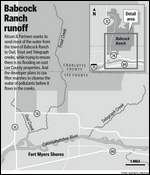
Cattle feed on land owned by Jim English in
Alva. The land is adjacent to Babcock Ranch. English believes developing
the Babcock land will cause more flooding on his land, which already
floods in the wet season.
Newspress.Com
Babcock Ranch plans stir
water fears
Developer vows town will have 'no impact'
http://www.news-press.com/apps/pbcs.dll/article?AID=/20070624/BABCOCK/706240398
Jim English expects his Alva farm to flood during
the next couple of months. It's the rainy season.
But what will happen, he wonders, if a West Palm Beach developer builds a new
town just north of him that exceeds today's state water runoff limit by 45
percent?
"Flooding damages our pasture and our citrus grove, and that reduces our
income," English said, not elaborating on the financial impact.
"People need to understand that we've got a problem."
|
|
"We noticed that the figures ... seemed to
be higher than the ones allowed in our (water) discharge rate map," said
Ricardo Valera, a division director with the water management district, which
oversees these kinds of water issues in Southwest Florida.
This is the first of two permits Kitson & Partners must acquire from the
district, with more permits needed from governing agencies such as the U.S. Army
Corps of Engineers, the Florida Fish and Wildlife Conservation Commission and
Charlotte County.
Syd Kitson, chairman of the company, promotes his development as a hybrid — a
self-sustaining town where people and the environment co-exist.
"We're talking it through right
now," he said of the permit. "We're
going to do everything we can so things work out for everybody."
The 800-acre English farm, where cattle is raised and citrus grown, has been in
the same family for nearly 130 years.
"My grandfather came there by ox cart in 1878, from southern Georgia. It
took him six weeks," English said. "I'm the fourth generation in my
family that that piece of land has provided an income to."
 |
The biggest neighboring development in the works is Kitson's, planned on 17,000 acres that straddle the boundaries of northeast Lee and southeast Charlotte counties. Kitson is focusing on the 13,000-plus acres in Charlotte for now, because he has not yet gotten approval to create a special district in Lee that would generate money for roads and sewers.
The Charlotte piece will discharge water at a
rate of 39 cubic feet per second per square mile, potentially enough to cause
some flooding, the water management district report shows.
That rate of water release is allowed in Lee, but in Charlotte, the water
management district restricts water releases to 26.9 cubic feet per second per
square mile.
That means Kitson & Partners is surpassing the district's water discharge
limit by 45 percent.
"The secret to the success of the design is
water that leaves the site has to be held back, and they have to treat it and
release it slowly," Valera said. "It won't get worse. That's part of
the review process."
English, an Alva resident all his life, has been proactive.
Not only is he following every step of the water
management district process, he has hired his own consultant.
Tommy Perry, an engineer with Johnson-Prewitt & Associates Inc. in
Clewiston, believes Kitson's proposal needs work. How does Kitson plan to keep
water from Cypress Creek, notorious for overflowing and flooding parts of Alva,
including English's farm? How does Kitson plan to direct the water toward Owl,
Trout and Telegraph creeks instead?
"Their plan doesn't fully address the problem as it is right now,"
Perry said. "They are legitimate questions."
Kitson believes he can answer them. If there is
too much discharge, regardless of what is and is not allowed, he wants to
address that.
"There should be no impact," he said. The water "is going to run
off at a rate that does not impact those people (in east Lee County). Period.
There is no other alternative."
That leaves one more major water issue to
address: the Caloosahatchee River.
The water management district's limit of 26.9 cubic feet per second per square
mile applies to runoff flowing into the river too.
Ruby Daniels, president of the grass roots civic group ALVA Inc., was concerned
from the beginning, when Kitson & Partners bought Babcock and planned to
develop part of it.
"ALVA Inc. is trying to preserve the natural
beauty of the area and that's a huge challenge when people are trying to develop
large tracts of land," she said.
Runoff heads south and eventually ends up in the Caloosahatchee, which flows to
the Gulf of Mexico, one of the gems of Lee County's $2 billion tourism and
hospitality industry. Dirty water that flows to the Gulf can bring algae to
Lee's beaches, clouding the water and creating a horrible smell.
The Babcock water will be treated, Kitson said,
in the filter marshes along the southern edge of his town.
"That water is going to be cleaner," he said.
English is keeping an open mind, and he will be watching.
"I'll have to see what the plan is" when it's done, he said.